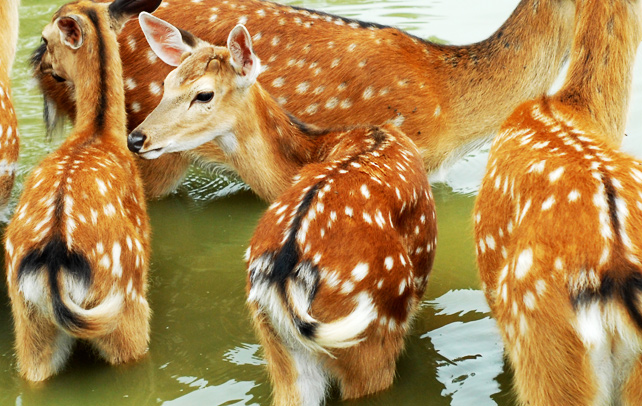Interesting Facts About Deer

Bambi and Rudolph may be the best-known deer, but there is more to know and explore about these cervids than their fictitious counterparts. The most frivolous and docile of all wood-dwelling wildlife, deer is one of the most prized ruminants, usually sought for its meat and hide. Found all throughout Asia, Europe, North America, South America and Northern Africa, this hoofed artiodactyl mammal has as many as 100 different varieties. One intriguing thing that makes deer truly unique is their deciduous antlers, which they grow during the spring and shed during the winter. Capable of adapting well with almost every environmental condition, deer is found all across the globe, except for Australia and Antarctica. Deer is blessed with great sense of hearing. Also, they can hear higher frequency sounds than human beings. These herbivore ruminants feed on grass, plants, bushes and saplings. They have their own territories and they prefer to live there even in worst environmental conditions. It is said that they prefer to starve rather than leave their territory in search of food. Read on to know more facts about deer.
Fast Facts
Type: Mammal
Kingdom: Animalia
Phylum: Chordata
Class: Mammalia
Infraclass: Eutheria
Order: Artiodactyla
Suborder: Ruminantia
Infraorder: Pecora
Family: Cervidae
Diet: Herbivore
Size: 3 ft. – 6ft. (depends on the species)
Weight: 30 to 300 kilograms (70 to 700 lb) (depends upon species)
Group Name: Herd
Lifespan: About 20 years
Habitat: Open land, woodland, swamps and mountains
Sexual Maturity: 16 months- 2 years (depends upon species)
Gestation Period: 200 days (depends upon species)
Number of Offspring: 1-2 per litter
Interesting Facts About Deer
- Deers have hoofs with even number of toes.
- Whitetail deer, moose, reindeer, mule deer, black tail deer, elk, caribou, etc. are some species of deer.
- Male deer are usually referred to as bucks, bulls, stags or harts while does, cows or hinds indicate females. Young deer are referred to as fawns or calves.
- Deers are the only animals that have antlers (antlers are different from horns). Antlers are the fastest living tissue. They start growing in the spring, during which the antlers are covered with velvet like skin (soft tissues). These antlers become hard during the fall and lose their soft coat. In winter, these antlers shed and this cycle is repeated.
- Deers have a great sense of hearing. They have many muscles attached to their ears, which allow them to turn their ears in any direction, without moving their heads. They can hear higher frequency sound with ease.
- Their brown-fawn coat is of great advantage as it serves as a camouflage. They stand still when the predators approaches and save themselves.
- Deers shed the summer coat and develop a thicker winter coat during winter season.
- Deers have a capacity for 310-degree vision, but find it difficult to focus on a single point. Deer are blessed with excellent night vision.
- Deers have small teeth in the front part of the lower jaw, which help in tearing food, but it lacks teeth in the front side of the upper jaw. These teeth are substituted with hard palate, which serves the same function of the tooth. They have molars, canines and incisors that help them chew food.
- Deers are ungulates walking on two-toed hoofs. Their long legs with powerful muscles aid them to run at a speed of 40 miles per hour and jump at 10 feet high. They are fast swimmers as well.
- Deers have excellent olfactory sense that helps them detect predators from long distance by detecting smell. To keep the nose moist and improve olfactory reception, they lick their nose often. Nose serves the additional function of communication too.
- The rut period, the breeding period is from October and January. The neck region of the male deer swells up during this period and the antler loses its velvet coat. This enables the male to fight and establish their dominance during the breeding season.
- Fawns lack scent and this aid in their protection from predators. Though the fawns are able to stand within half-an-hour of birth, their mother constantly protects them. The young ones are usually fed six times a day and they remain with mother for more than a year. When deer feel threatened, they raise their tail to warn other deer.
- Bucks have separate territory for them. They mark their territory with scrapping on the land with their hooves. Also, they remove tree barks with their antlers to mark their territory. These marks on the trees are called “buck rubs”.
- Deers are herbivores animals that thrive on grass, leaves, stems, shoots, berries, herbs, acorns, mushrooms, wild fruit, etc.
- Being ruminants, deer eat in the morning and this food is stored in the first chamber of their stomach. This is again brought back to the mouth and chewed again. This then goes to the third and fourth chamber for digestion.
- Deers become less active during winter months.









